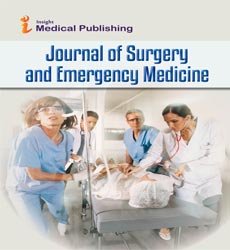The foam sclerotherapy vs conventional sclerotherapy in normal treatment of multiple haemorrhoids with 3% polidocanol â?? a comparative study now a days
Abstract
Pulmonary Haemorrhoidal disease is of enormous epidemiological and economic relevance, as it represents a common disease worldwide with a peak of prevalence at the age of 45 to 65 years in both genders [1]. According to the traditional classification, the disease is divided into four grades depending on the extent of the prolapse into the anal canal or outside the anus. There are various methods of treatment based on the degree of Haemorrhoids.
Recently Minimal Invasive Procedure for Haemorrhoids (MIPH) has evolved as an alternative to these Surgical procedures. Depending on the severity of haemorrhoidal disease, dietary measures, sclerotherapy, rubber band ligation and various surgical procedures (Milligan-Morgan haemorrhoidectomy or Ferguson haemorrhoidectomy) are mainly used for treatment [2, 3, 4].
Sclerotherapy is defined as the targeted elimination of small vessels, varicose veins, and vascular anomalies by the injection of a sclerosant. Polidocanol is the most widely used sclerosant in Sclerotherapy in western countries. Chemical Sclerotherapy has been performed for over 75 years [5]. The direct intravascular injection of liquid or foamed agent stimulates [6,7] endothelial cells damage of target vessels and then stimulates transmural vessel walls. The sclerotherapy damages the vessel wall and transforms it into fibrous tissue [8,9].
This procedure causes minimal discomfort to the patient, negligible blood loss, less cumbersome, minimal surgical expertise is required, and above all is economical. There is no requirement of local anaesthesia or postoperative dressings or any specific care [8-11, 12]. The patient can resume his daily activities immediately. This clinical study is aimed to compare the efficacy and safety of foam sclerotherapy and conventional sclerotherapy in the treatment of multiple hemorrhoids with 3% polidocanol.
Pulmonary Haemorrhoidal disease is of enormous epidemiological and economic relevance, as it represents a common disease worldwide with a peak of prevalence at the age of 45 to 65 years in both genders [1]. According to the traditional classification, the disease is divided into four grades depending on the extent of the prolapse into the anal canal or outside the anus. There are various methods of treatment based on the degree of Haemorrhoids.
Recently Minimal Invasive Procedure for Haemorrhoids (MIPH) has evolved as an alternative to these Surgical procedures. Depending on the severity of haemorrhoidal disease, dietary measures, sclerotherapy, rubber band ligation and various surgical procedures (Milligan-Morgan haemorrhoidectomy or Ferguson haemorrhoidectomy) are mainly used for treatment [2, 3, 4].
Sclerotherapy is defined as the targeted elimination of small vessels, varicose veins, and vascular anomalies by the injection of a sclerosant. Polidocanol is the most widely used sclerosant in Sclerotherapy in western countries. Chemical Sclerotherapy has been performed for over 75 years [5]. The direct intravascular injection of liquid or foamed agent stimulates [6,7] endothelial cells damage of target vessels and then stimulates transmural vessel walls. The sclerotherapy damages the vessel wall and transforms it into fibrous tissue [8,9].
This procedure causes minimal discomfort to the patient, negligible blood loss, less cumbersome, minimal surgical expertise is required, and above all is economical. There is no requirement of local anaesthesia or postoperative dressings or any specific care [8-11, 12]. The patient can resume his daily activities immediately. This clinical study is aimed to compare the efficacy and safety of foam sclerotherapy and conventional sclerotherapy in the treatment of multiple hemorrhoids with 3% polidocanol.
Open Access Journals
- Aquaculture & Veterinary Science
- Chemistry & Chemical Sciences
- Clinical Sciences
- Engineering
- General Science
- Genetics & Molecular Biology
- Health Care & Nursing
- Immunology & Microbiology
- Materials Science
- Mathematics & Physics
- Medical Sciences
- Neurology & Psychiatry
- Oncology & Cancer Science
- Pharmaceutical Sciences
